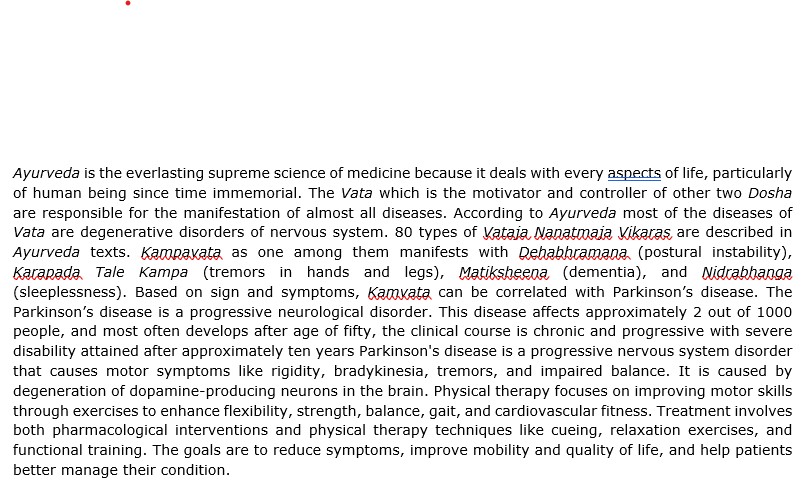Ayurvedic management of Kampvata - A Case Study
DOI:
https://doi.org/10.21760/jaims.9.6.54Keywords:
Kampvata, Vataja Nanatmaja Vikaras, Parkinson’sAbstract
Ayurveda is the everlasting supreme science of medicine because it deals with every aspects of life, particularly of human being since time immemorial. The Vata which is the motivator and controller of other two Dosha are responsible for the manifestation of almost all diseases. According to Ayurveda most of the diseases of Vata are degenerative disorders of nervous system. 80 types of Vataja Nanatmaja Vikaras are described in Ayurveda texts. Kampavata as one among them manifests with Dehabhramana (postural instability), Karapada Tale Kampa (tremors in hands and legs), Matiksheena (dementia), and Nidrabhanga (sleeplessness). Based on sign and symptoms, Kamvata can be correlated with Parkinson’s disease. The Parkinson’s disease is a progressive neurological disorder. This disease affects approximately 2 out of 1000 people, and most often develops after age of fifty, the clinical course is chronic and progressive with severe disability attained after approximately ten years Parkinson's disease is a progressive nervous system disorder that causes motor symptoms like rigidity, bradykinesia, tremors, and impaired balance. It is caused by degeneration of dopamine-producing neurons in the brain. Physical therapy focuses on improving motor skills through exercises to enhance flexibility, strength, balance, gait, and cardiovascular fitness. Treatment involves both pharmacological interventions and physical therapy techniques like cueing, relaxation exercises, and functional training. The goals are to reduce symptoms, improve mobility and quality of life, and help patients better manage their condition.
Downloads
References
Charak Samhita With Ayurveda Dipika Commentary of Chakrapani Datta, Ed. Yadavji Trikarma Ji Acharya, Chaukhambha Surbharti Prakashan, Varanasi. Charaka samhita Sutrasthan Chapter 20 verse 9.
Charak Samhita With Ayurveda Dipika Commentary of Chakrapani Datta, Ed. Yadavji Trikarma Ji Acharya, Chaukhambha Surbharti Prakashan, Varanasi. Charaka samhita Sutrasthan Chapter 17 verse 61.
Charak Samhita With Ayurveda Dipika Commentary of Chakrapani Datta, Ed. Yadavji Trikarma Ji Acharya, Chaukhambha Surbharti Prakashan, Varanasi. Charaka Samhita Sutrasthan Chapter 17 verse 65.
Gupt KA. Ashtanga Hridaya, Sutra Sthana 13/1-3, Chaukhamba Sanskruta Sansthana, Varanasi Ed 2000 p-96.18.
Tripathi B. Charaka Samhita Sutra sthana 22/11, Chaukhamba Surabharati Prakashana Varanasi. 2014 p-413















